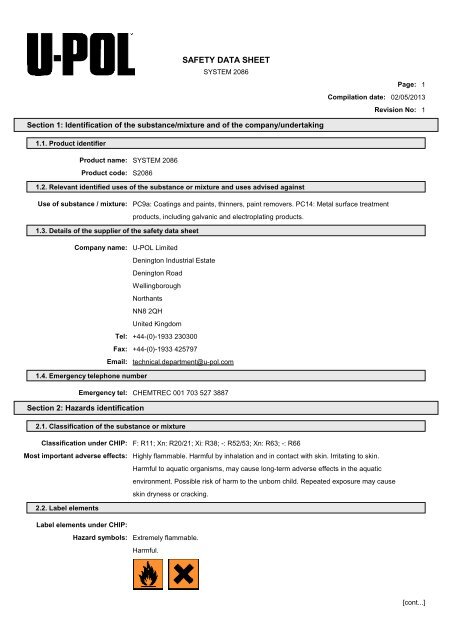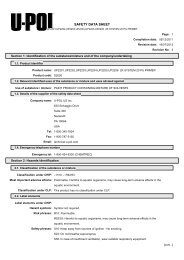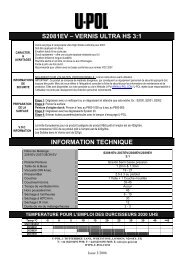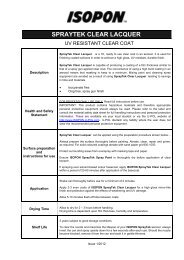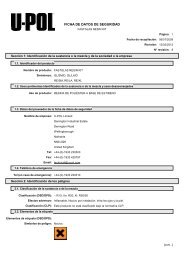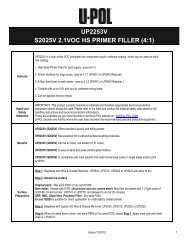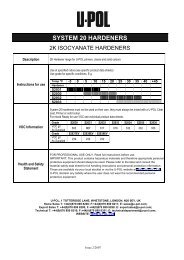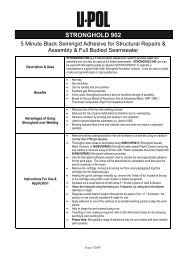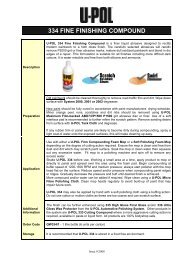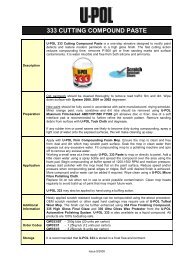SAFETY DATA SHEET - U-Pol
SAFETY DATA SHEET - U-Pol
SAFETY DATA SHEET - U-Pol
Create successful ePaper yourself
Turn your PDF publications into a flip-book with our unique Google optimized e-Paper software.
<strong>SAFETY</strong> <strong>DATA</strong> <strong>SHEET</strong>SYSTEM 2086Page: 1Compilation date: 02/05/2013Revision No: 1Section 1: Identification of the substance/mixture and of the company/undertaking1.1. Product identifierProduct name: SYSTEM 2086Product code:S20861.2. Relevant identified uses of the substance or mixture and uses advised againstUse of substance / mixture:PC9a: Coatings and paints, thinners, paint removers. PC14: Metal surface treatmentproducts, including galvanic and electroplating products.1.3. Details of the supplier of the safety data sheetCompany name: U-POL LimitedDenington Industrial EstateDenington RoadWellingboroughNorthantsNN8 2QHUnited KingdomTel: +44-(0)-1933 230300Fax: +44-(0)-1933 425797Email: technical.department@u-pol.com1.4. Emergency telephone numberEmergency tel: CHEMTREC 001 703 527 3887Section 2: Hazards identification2.1. Classification of the substance or mixtureClassification under CHIP:Most important adverse effects:F: R11; Xn: R20/21; Xi: R38; -: R52/53; Xn: R63; -: R66Highly flammable. Harmful by inhalation and in contact with skin. Irritating to skin.Harmful to aquatic organisms, may cause long-term adverse effects in the aquaticenvironment. Possible risk of harm to the unborn child. Repeated exposure may causeskin dryness or cracking.2.2. Label elementsLabel elements under CHIP:Hazard symbols:Extremely flammable.Harmful.[cont...]
Risk phrases:Safety phrases:Precautionary phrases:<strong>SAFETY</strong> <strong>DATA</strong> <strong>SHEET</strong>SYSTEM 2086Page: 2R11: Highly flammable.R20/21: Harmful by inhalation and in contact with skin.R38: Irritating to skin.R52/53: Harmful to aquatic organisms, may cause long-term adverse effects in theaquatic environment.R63: Possible risk of harm to the unborn child.R66: Repeated exposure may cause skin dryness or cracking.S36/37: Wear suitable protective clothing and gloves.Contains chisorb 5530, bis(1,2,2,6,6-pentamethyl-4-piperidyl) sebacate. May produce anallergic reaction.2.3. Other hazardsPBT:This substance is not identified as a PBT substance.Section 3: Composition/information on ingredients3.2. MixturesHazardous ingredients:N-BUTYL ACETATEEINECS CAS CHIP Classification CLP Classification Percent204-658-1 123-86-4 -: R10; -: R66; -: R67Substance with a Communityworkplace exposure limit.XYLENE - REACH registered number(s): 01-2119486136-34-0000Flam. Liq. 3: H226; STOT SE 3: H336;-: EUH06620-30%215-535-7 1330-20-7 -: R10; Xn: R20/21; Xi: R38 Flam. Liq. 3: H226; Acute Tox. 4: H332;Acute Tox. 4: H312; Skin Irrit. 2: H31512.5-20%TOLUENE203-625-9 108-88-3 F: R11; Xi: R38; Xn: R48/20; Xn:R63; Xn: R65; -: R674-METHYLPENTAN-2-ONEFlam. Liq. 2: H225; Repr. 2: H361d;Asp. Tox. 1: H304; STOT RE 2: H373;Skin Irrit. 2: H315; STOT SE 3: H3361-12.5%203-550-1 108-10-1 F: R11; Xn: R20; Xi: R36/37; -: R66 Flam. Liq. 2: H225; Acute Tox. 4: H332;Eye Irrit. 2: H319; STOT SE 3: H335; -:EUH0661-12.5%ETHYLBENZENE202-849-4 100-41-4 F: R11; Xn: R20 Flam. Liq. 2: H225; Acute Tox. 4: H332 1-12.5%[cont...]
<strong>SAFETY</strong> <strong>DATA</strong> <strong>SHEET</strong>SYSTEM 2086Page: 32-METHOXY-1-METHYLETHYL ACETATE203-603-9 108-65-6 -: R10Substance with a Communityworkplace exposure limit.Flam. Liq. 3: H226 1-12.5%LOW BOILING POINT NAPHTHA - UNSPECIFIED - SOLVENT NAPHTHA (PETROLEUM), LIGHT AROM.. - REACHregistered number(s): 01-2119455851-35-XXXX265-199-0 64742-95-6 -: R10; Xi: R37; N: R51/53; Xn:R65; -: R66; -: R67CHISORB 5530STOT SE 3: H335; STOT SE 3: H336;Aquatic Chronic 2: H411; Flam. Liq. 3:H226; Asp. Tox. 1: H3041-12.5%- - Sens.: R43; N: R51/53 -
<strong>SAFETY</strong> <strong>DATA</strong> <strong>SHEET</strong>SYSTEM 2086Page: 4Section 5: Fire-fighting measures5.1. Extinguishing mediaExtinguishing media:Suitable extinguishing media for the surrounding fire should be used. Use water sprayto cool containers.5.2. Special hazards arising from the substance or mixtureExposure hazards:In combustion emits toxic fumes.5.3. Advice for fire-fightersAdvice for fire-fighters:Wear self-contained breathing apparatus. Wear protective clothing to prevent contactwith skin and eyes.Section 6: Accidental release measures6.1. Personal precautions, protective equipment and emergency proceduresPersonal precautions:Refer to section 8 of SDS for personal protection details. Eliminate all sources ofignition. If outside do not approach from downwind. If outside keep bystanders upwindand away from danger point. Mark out the contaminated area with signs and preventaccess to unauthorised personnel. Do not attempt to take action without suitableprotective clothing - see section 8 of SDS. Turn leaking containers leak-side up toprevent the escape of liquid.6.2. Environmental precautionsEnvironmental precautions:Do not discharge into drains or rivers. Contain the spillage using bunding. Alert theneighbourhood to the presence of fumes or gas.6.3. Methods and material for containment and cleaning upClean-up procedures:Clean-up should be dealt with only by qualified personnel familiar with the specificsubstance. Absorb into dry earth or sand. Transfer to a closable, labelled salvagecontainer for disposal by an appropriate method. Do not use equipment in clean-upprocedure which may produce sparks.6.4. Reference to other sectionsReference to other sections:Refer to section 8 of SDS. Refer to section 13 of SDS.Section 7: Handling and storage7.1. Precautions for safe handlingHandling requirements:Avoid direct contact with the substance. Ensure there is sufficient ventilation of the area.Do not handle in a confined space. Avoid the formation or spread of mists in the air.Smoking is forbidden. Use non-sparking tools.7.2. Conditions for safe storage, including any incompatibilitiesStorage conditions:Store in cool, well ventilated area. Keep away from sources of ignition. Keep container[cont...]
Suitable packaging:<strong>SAFETY</strong> <strong>DATA</strong> <strong>SHEET</strong>SYSTEM 2086Page: 5tightly closed. Prevent the build up of electrostatic charge in the immediate area. Ensurelighting and electrical equipment are not a source of ignition. The floor of the storageroom must be impermeable to prevent the escape of liquids.Must only be kept in original packaging.7.3. Specific end use(s)Specific end use(s):No data available.Section 8: Exposure controls/personal protection8.1. Control parametersHazardous ingredients:N-BUTYL ACETATEWorkplace exposure limits:Respirable dustState 8 hour TWA 15 min. STEL 8 hour TWA 15 min. STELUK 724 mg/m3 966 mg/m3 - -XYLENEUK 220 mg/m3 441 mg/m3 - -TOLUENEUK 191 mg/m3 384 mg/m3 - -4-METHYLPENTAN-2-ONEUK 208 mg/m3 416 mg/m3 - -ETHYLBENZENEUK 441 mg/m3 552 mg/m3 - -2-METHOXY-1-METHYLETHYL ACETATEUK 274 mg/m3 548 mg/m3 - -8.2. Exposure controlsEngineering measures:Respiratory protection:Hand protection:Eye protection:Skin protection:Environmental:Ensure there is sufficient ventilation of the area.Respiratory protective device with particle filter. Gas/vapour filter, type B: inorganicvapours excl. CO (EN141).Impermeable gloves.Safety glasses with side-shields. Ensure eye bath is to hand.Impermeable protective clothing.Prevent from entering in public sewers or the immediate environment.Section 9: Physical and chemical properties9.1. Information on basic physical and chemical propertiesState:Colour:LiquidColourless[cont...]
<strong>SAFETY</strong> <strong>DATA</strong> <strong>SHEET</strong>SYSTEM 2086Odour: AromaticEvaporation rate: ModerateOxidising: Non-oxidising (by EC criteria)Solubility in water: InsolubleAlso soluble in: Most organic solvents.Viscosity: ViscousBoiling point/range°C: >35 Flash point°C: -6Relative density: 0.95 VOC g/l: 602Page: 69.2. Other informationOther information:Not applicable.Section 10: Stability and reactivity10.1. ReactivityReactivity:Stable under recommended transport or storage conditions.10.2. Chemical stabilityChemical stability:Stable under normal conditions.10.3. Possibility of hazardous reactionsHazardous reactions:Hazardous reactions will not occur under normal transport or storage conditions.Decomposition may occur on exposure to conditions or materials listed below.10.4. Conditions to avoidConditions to avoid:Heat. Hot surfaces. Sources of ignition. Flames.10.5. Incompatible materialsMaterials to avoid:Strong oxidising agents. Strong acids.10.6. Hazardous decomposition productsHaz. decomp. products:In combustion emits toxic fumes.Section 11: Toxicological information11.1. Information on toxicological effectsRelevant effects for mixture:Effect Route BasisAcute toxicity (harmful) INH DRM Hazardous: calculatedIrritation DRM Hazardous: calculatedSymptoms / routes of exposureSkin contact:Eye contact:Ingestion:There may be irritation and redness at the site of contact.There may be irritation and redness. The eyes may water profusely.There may be soreness and redness of the mouth and throat. Nausea and stomachpain may occur. There may be vomiting.[cont...]
Inhalation:Delayed / immediate effects:<strong>SAFETY</strong> <strong>DATA</strong> <strong>SHEET</strong>SYSTEM 2086There may be irritation of the throat with a feeling of tightness in the chest.Immediate effects can be expected after short-term exposure.Page: 7Section 12: Ecological information12.1. ToxicityEcotoxicity values:Not applicable.12.2. Persistence and degradabilityPersistence and degradability:No data available.12.3. Bioaccumulative potentialBioaccumulative potential:No data available.12.4. Mobility in soilMobility:No data available.12.5. Results of PBT and vPvB assessmentPBT identification:This substance is not identified as a PBT substance.12.6. Other adverse effectsOther adverse effects:Harmful to aquatic organisms.Section 13: Disposal considerations13.1. Waste treatment methodsDisposal operations:NB:Transfer to a suitable container and arrange for collection by specialised disposalcompany.The user's attention is drawn to the possible existence of regional or nationalregulations regarding disposal.Section 14: Transport information14.1. UN numberUN number:UN126314.2. UN proper shipping nameShipping name:PAINT14.3. Transport hazard class(es)14.4. Packing groupTransport class: 3Packing group:II14.5. Environmental hazardsEnvironmentally hazardous: No Marine pollutant: No[cont...]
<strong>SAFETY</strong> <strong>DATA</strong> <strong>SHEET</strong>SYSTEM 2086Page: 814.6. Special precautions for userSpecial precautions: No special precautions.Tunnel code: D/ETransport category: 2Section 15: Regulatory information15.1. Safety, health and environmental regulations/legislation specific for the substance or mixtureSpecific regulations:This product is a Seveso category/named substance in Annex I of Council Directive96/82/EC.15.2. Chemical Safety AssessmentChemical safety assessment:A chemical safety assessment has not been carried out for the substance or the mixtureby the supplier.Section 16: Other informationOther informationOther information:Phrases used in s.2 and 3:This safety data sheet is prepared in accordance with Commission Regulation (EU) No453/2010.* indicates text in the SDS which has changed since the last revision.EUH066: Repeated exposure may cause skin dryness or cracking.H225: Highly flammable liquid and vapour.H226: Flammable liquid and vapour.H304: May be fatal if swallowed and enters airways.H312: Harmful in contact with skin.H315: Causes skin irritation.H317: May cause an allergic skin reaction.H319: Causes serious eye irritation.H332: Harmful if inhaled.H335: May cause respiratory irritation.H336: May cause drowsiness or dizziness.H361d: Suspected of damaging the unborn child.H373: May cause damage to organs throughprolonged or repeated exposure .H400: Very toxic to aquatic life.H410: Very toxic to aquatic life with long lasting effects.H411: Toxic to aquatic life with long lasting effects.R10: Flammable.R11: Highly flammable.R20/21: Harmful by inhalation and in contact with skin.[cont...]
Legal disclaimer:<strong>SAFETY</strong> <strong>DATA</strong> <strong>SHEET</strong>SYSTEM 2086Page: 9R20: Harmful by inhalation.R36/37: Irritating to eyes and respiratory system.R37: Irritating to respiratory system.R38: Irritating to skin.R43: May cause sensitisation by skin contact.R48/20: Harmful: danger of serious damage to health by prolonged exposure throughinhalation.R50/53: Very toxic to aquatic organisms, may cause long-term adverse effects in theaquatic environment.R51/53: Toxic to aquatic organisms, may cause long-term adverse effects in the aquaticenvironment.R52/53: Harmful to aquatic organisms, may cause long-term adverse effects in theaquatic environment.R63: Possible risk of harm to the unborn child.R65: Harmful: may cause lung damage if swallowed.R66: Repeated exposure may cause skin dryness or cracking.R67: Vapours may cause drowsiness and dizziness.The above information is believed to be correct but does not purport to be all inclusiveand shall be used only as a guide. This company shall not be held liable for anydamage resulting from handling or from contact with the above product.[final page]


